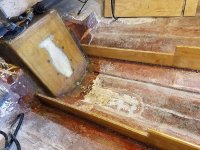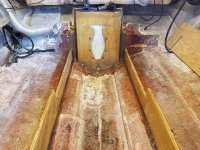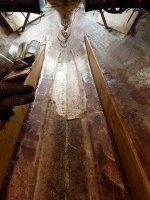PC on the Bayou
Petty Officer 1st Class
- Joined
- Apr 27, 2020
- Messages
- 234
Guess you gotta be way less particular than me to make a living at this work.
I guess that is the reason we see all of the flaws in the mass produced OEM jobs.















Guess you gotta be way less particular than me to make a living at this work.
Nice work on the scarf joints. It's a shame they will be hidden. At least you have photos of them on the internet, eh?
I wish I had known that trick with the transom holes when I did mine. Not easy to seal them otherwise.
Thoughts on transom gluing: When I set my transom in, I wetted the ply with laminating (poly) resin until it was done drinking that in, and let it kick. Then I laid up about 4 layers of CSM dry, holding it in place with a handful of staples. With the transom wood flat, I soaked it thoroughly. Then I wetted the hull and clamped it in place, working bottom to top.
I mixed my resin on the slow side and had plenty of time.
The point I'm trying to make that might work for you is the layers of CSM instead of PB. Once the resin dissolved the styrene binder in the CSM, it was like having a very evenly applied layer of PB about 1/8" thick. It conformed nicely to the small irregularities of the hull. (Large irregularities were already filled and leveled.) Working by myself, this seemed to go more quickly and controllably than mixing large batches of PB and trying to spread it quickly and evenly. The CSM was stapled in place on the wood, and all I had to do was saturate it.
Just food for thought. I know that epoxy doesn't melt the styrene as well as Poly does, so that might be a consideration. Maybe some of the others have thoughts on this method.
And you used PB / thickened polyester resin to glue the transom in? How did you feel about the working time to spread it and get it clamped?
That's what I want to hear! The transom being so large has me nervous about the PB kicking before I'm ready, but I'll almost certainly be installing it in the winter in my climate controlled garage, so I should be able to achieve whatever ambient temperature I want. Hopefully by the time I'm ready to glue my new transom in I'll have gotten a good feel for mixing the resin to get the speed of cure I want.Yes, I glued it in with PB.
I have been mixing my resin on the slow side so I haven't had any issues with kicking off too quickly. Yesterday, it was a nice cool day (70 F) max; so, it went off really well to get it in place and clamped.
Hopefully by the time I'm ready to glue my new transom in I'll have gotten a good feel for mixing the resin to get the speed of cure I want.
How did you spread the PB on the transom? Did you use a notched trowel or some other method?I started all of my resin work with a slow mix ratio because I didn't want to be too rushed with anything. I would rather have to wait longer between tasks than to get half way through and have my resin hardening up on me.
It, also, makes it good for clean-up of tools and equipment after working with the resin. So far, I've been able to clean up my mixing cups, rollers, etc. very well.
I just did a thin layer with a trowel and clamped it good to get squeeze out.How did you spread the PB on the transom? Did you use a notched trowel or some other method?


